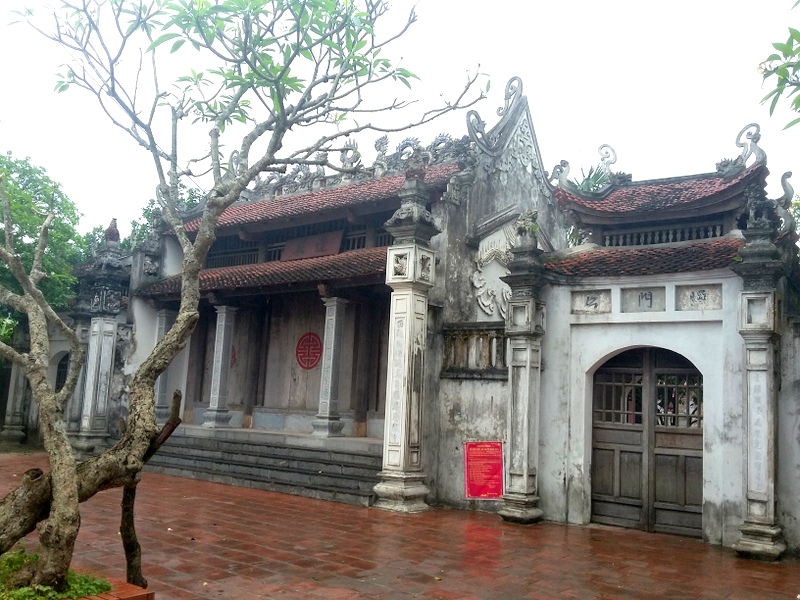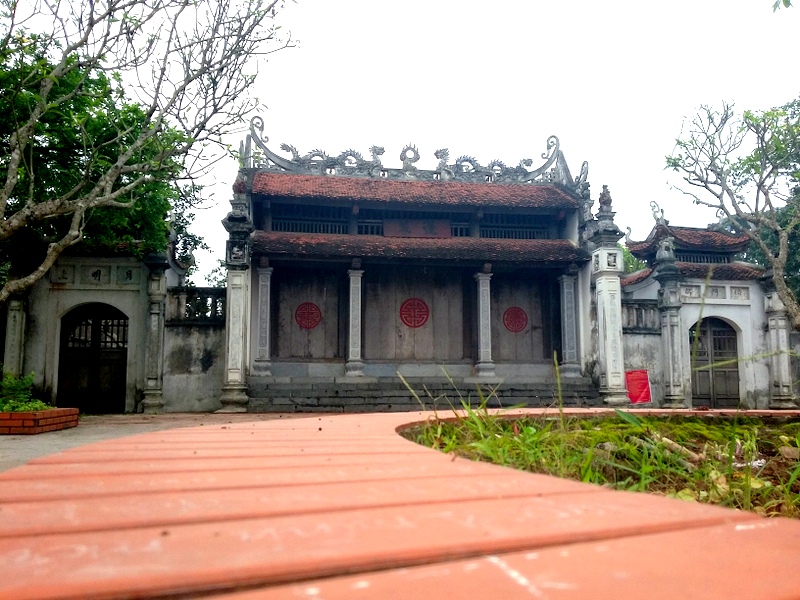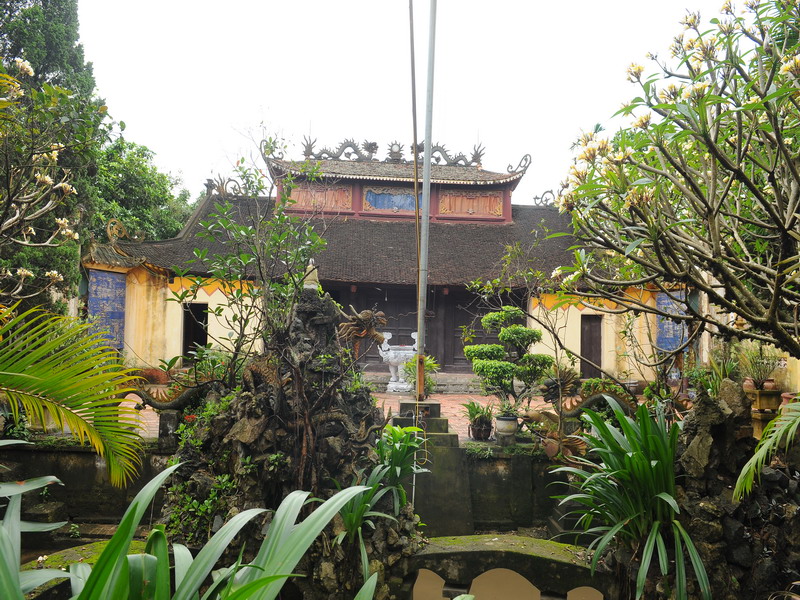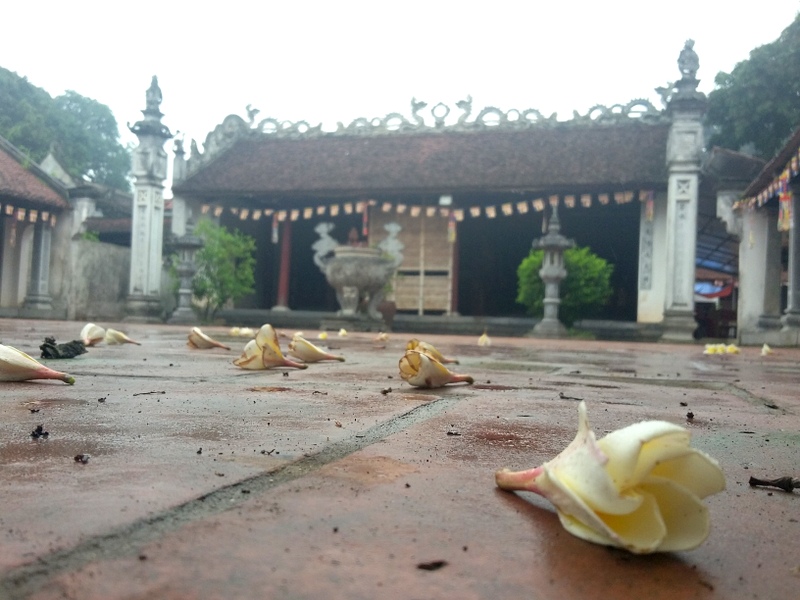Ba Danh Pagoda, also called Bao Son pagoda, located in Danh village, Ngoc Son commune, Kim Bang district.
Like other pagodas, Ba Danh pagoda was built to worship Buddha. However, besides the statue of Bo Tat (Bodhisattva), there are also the statues of Thai Thuong Lao Quan, Nam Tao (a constellation in the northern hemisphere), Bac Dau and the statues of Tu Phu belief (Four Dharmas), a popular belief of Viet Nam. The statues of Tu Phu belief appear here because the pagoda is a place to worship Tu Phap. The legend of Tu Phap, including four mothers “May” (Cloud Dharma), “Mua” (Rain Dharma), “Sam” (Thunder Dharma) and “Chop” (Lightning Dharma), is the mixture of Buddhism and local popular beliefs, which were written in Man Nuong story by Linh Nam Chinh Quai (Tran The Phap, 19th century, Vu Quynh – Kieu Phu, 1492).

The legend that Tu Phap was originated in Man Nuong Buddha spread throughout the north plain areas, and has been handed down here. In the past, Kim Bang people believed that Bac Ninh people met good weather and crops because they worshiped Tu Phap, therefore, they went to Bac Ninh to ask for the rests of burned incense. In the beginning, Tu Phap was worshipped in the village of Van Lam, Dang Xa, Van Chau, Bau Thon, Bai Le and then this custom has spread to other communes in Ha Nam of Day riverside.
People in Danh village also intended to ask for incense bases. The legend has it that there were heavy rain and strong wind here that damaged crops. One day, an old man had a dream that a beautiful girl with kind face, bright eyes and forehead talked to him that she was appointed to take care of local people, and then she showed him where they should build the pagoda. At that time, that land was only a dense wood with lots of century-old trees and birds.
At first the pagoda was built out of bamboo. In the year of Vinh Tri, Le Hy Tong’s reign, the forest was cleared to rebuild the pagoda. Local people were not allowed to build house there, therefore the scenery has been more and more solemn and deserted. Right after building the pagoda, an ancient jack tree was fallen and a strange person who had the same dream as the old man took its wood to sculpt a statue. In flood season of that year, when the flood-water level rose high, there was a wooden throne washed aside onto the river shore and didn’t drift downstream. Strangely, the statue fitted on the throne. Since that time, local people have met good weather and abundant crops. The supernatural power of Thanh Ba Bao Son (Bao Son’s Holy Mother) attracts the tourists from many areas. And helmsmen going through this area on flood season always burn incense in this pagoda to pray for safety.
Both this legend and the legend about Man Nuong have the same detail of drifting wood, and the two Genies in these two legends are Agriculture Nymph. Moreover, the legend of Ba Danh reflects the customs of people living along Day riverside to worship the Water Genie.
The pagoda faces to the south and is bordered by the road, and the three-door temple gate near the riverside. This work was built five steps higher, and its two sides were built in. The three-door temple gate is divided into three sections and two storeys: the upstairs is a campanile with two tile layers and a fence of pales, doors of three lower sections were made of iron wood. There are two bronze pillars outside the door, and two dragons looking back at each other on the top of three-door temple gate. Beside the main gate, there are two small gates with eight doors used on weekdays. The main entrance only opens on major holidays.

In the regions there are a flower garden, a tiled yard and two corridors. The forecourt and the sanctum have five sections with two built-in sides and tiled roof. They are connected by “Cua duc ban”. “Thuong dien” (the central temple) has three compartments with walls on the two sides and iron-wood door in front. The interior of the central temple is smaller but higher than that of the forecourt and the sanctum. To the west of the pagoda is a five-compartment house, its three middle ones are used to worship the last nuns, and the rest for monks. To the west is the palace to worship the Natural Mother that is next to the sanctum. The pagoda is encompassed by brick walls.
Ba Danh pagoda is the system of nearly 40 compartments. It was built a long time ago, and has been restored many times. But the other works have been built since the 19th century.
Ba Danh pagoda has long been referred to as a divine, secluded pagoda with picturesque scenery, which is a rare ancient and close beauty in Ha Nam province.

In the center of the ironwood screen in the lower floor of the pagoda’ three entrance gate, there is an engraver of five blessings (5 bats holding longevity letter in their mouths). On every pillar emerging from the 2 side walls, the ancient artists have sculpted four noble animals: dragon, unicorn, tortoise, and phoenix in lissome and symmetric position. On the roof of the gate, two dragons attending upon the moon were cast with lime, sand, and porcelain representing the dragon modeling style of the Nguyen dynasty. Notably, there are two stone dragons and two tigers symmetry locating along the two side stairways attending upon the service house. In comparison with the two dragons on the roof of the gate, the two stone dragons inside the gate are sculpted in a simpler manner and look gentler and slightly resemble the snake rather than varan. Similarly, the two tigers slanting 450 behind are also sculpted in a simple way which makes it look gentler than tigers carved in other regions. These are rare relics of important folklore value to be preserved.
Merely all the architecture and sculpture art of the pagoda are exhibited in the service house, the place where the Buddhist monks service everyday. The house consists of five rooms. The entire frame is made of ironwood. Two tipped gables are modeled with dragons. Standing in the middle of the yard, visitors can have their sense thrilled by the statue of 4 dragons attending upon the moon on the roof of the service house. The four dragons are in lissome position, with their vivid but fierce eyes, whiskers, claws; fins seem to be flying in the air, playing with each other. The statue represents characteristics of dragons under Nguyen Dynasty.

At the two ends of the corridors connecting to the service house, there stand 2 imposing pillars. Each pillar is sculpted with 4 noble animals: dragon, unicorn, tortoise, and phoenix in symmetric position, representing sense of harmonization and sustainability. All details of the creatures on the six pillars seem to exhibit meticulously, skillfulness and exquisite talent of the ancient artists.
The first rafter (from the west to the east) lies along the wall, is sculpted with tiger faced design, golden bamboo, roses, peach, and pomegranate. The front side of the second rafter is sculpted with 5 blessings (5 bats), apricot blossoms, roses, Vietnamese 36-cord zither, quill pen, fruit and a gourd of wine. On the backside are 5 dragons fighting over a pearl, roses, orchids and red munia. The front of the third rafter is sculpted with the 4 noble animals (dragon, unicorn, tortoise, and phoenix), pine-tree and horse, apricot blossom and bird. On the crossbeam are Vietnamese 16-chord zither, Vietnamese two-chord guitar. On the back are the 4 noble animals, a gourd of wine and a book. The upper front side of the fourth rafter is sculpted with two dragons attending upon the moon, and on the cross beam are roses, pine tree, coins, musical instrument, and flute. The front of the fifth rafter is sculpted with tiger face, 2 young lions. The crossbeam is sculpted with peaches, citrus fruits, pomegranates, roses, and bat. On the back are the five blessings, peaches, and roses. The sixth rafter has one side against the wall, and on the other side is tiger faced design, dragon-like pine tree, golden bamboo. On the upper part of the cross beam are peach fruit, apricot blossoms, ivory bamboo, grapes, pomegranates, peach and apricot tree, and cloth fan. Apart from the six rafters, there are 4 iron wood pillars, standing between the service house and the central house. The stem of the each pillar is meticulously sculpted with a flying dragon looking to the worship altar in the center of the third room.
The ancient craftsmen usually sculpted creatures on such topics as: The 4 noble animals (dragon, unicorn, tortoise and phoenix); the five blessings (5 bats), 2 dragons attending upon the moon, 5 dragons fighting over a pearl, 4 dragons attending upon the moon, and plants on such topics as: the 4 plants (pine tree, chrysanthemum, ivory bamboo and apricot), bowl of fruits (peach, grapes, pomegranate, fig fruit, Buddha’s hand fruit) or such topics on the combination of plants and creatures as: apricot blossom and bird; fir-tree and horse, golden bamboo, dragon-like pine tree… Besides, there are also some familiar topics like Vietnamese musical instruments: 16-chord zither, two-chord guitar, castanets and quill pen, a gourd of wine, fig fruit fan, which are considered to be the 8 valuable things. The ancient artisans have combined topics on symbolic creatures of the royal art (the four noble animals, five blessings, 2 dragons attending upon the moon, 5 dragons fighting over a pearl, apricot blossom and bird, the 4 plants (pine tree, chrysanthemum, ivory bamboo and apricot blossom), pine-tree and horse…) with familiar folklore topics (five fruits, bowl of fruits, folklore musical instruments, flute, two-string violin, castanets). They have also skillfully combined different sculpture methods, dragon-sculpting styles, intaglio to create symbolic but still lively and vivid creatures.
In the top hall of Ba Danh pagoda, there a many Buddha statues, including Tam The (God of past, present and future), the Jade Emperor (the Ruler of Heaven), old man Quan forefather, and Queen Danh statue, among which Queen Danh statue is the center of the pagoda. Queen Danh statue is cast sitting in meditation on a shiny black throne (not on a Buddha’s throne) with an indulgent, beautiful face, looking so close but not mystical or in salvation like other Buddha statues. The harmonization of the statue and the throne presents an attraction of the sculpture art of Ba Danh pagoda.

 English
English






Post Discussion